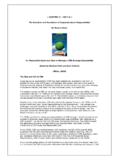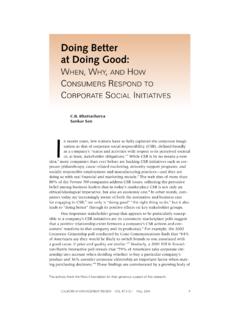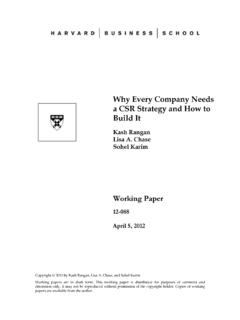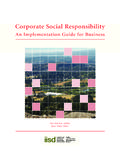Transcription of REVISITING CARROLL’S CSR PYRAMID - Wayne Visser
1 CHAPTER 1 REVISITING carroll S CSR PYRAMID AN AFRICAN PERSPECTIVE Wayne Visser Fellow, The University of Nottingham, United Kingdom. Special Advisor, Sustainability Services, KPMG South Africa African poverty and stagnation is the greatest tragedy of our time. Commission for Africa, 2005 Abstract This chapter explores the nature of corporate social responsibility (CSR) in an African context, using carroll s CSR PYRAMID as a framework for descriptive analysis. carroll s CSR PYRAMID is probably the most well-known model of CSR, with its four levels indicating the relative importance of economic, legal, ethical and philanthropic responsibilities respectively. However, the exploration of CSR in Africa is also used to challenge the accuracy and relevance carroll s CSR PYRAMID . If carroll s basic four-part model is accepted, it is suggested that the relative priorities of CSR in Africa are likely to be different from the classic, American ordering.
2 However, it is also proposed that carroll s CSR PYRAMID may not be the best model for understanding CSR in general, and CSR in Africa in particular. Wayne Visser 30 Introduction This chapter has two primary objectives: 1) to use carroll s corporate social responsibility (CSR) PYRAMID to illustrate the nature of CSR in Africa; and 2) to use the context of Africa to demonstrate the limitations of carroll s CSR PYRAMID as a framework for understanding CSR. Anglo American is used as a case study to illustrate the debate. The African Context The debate over Africa s future has taken centre stage recently, with the publication of Our Common Interest, the report of the Commission for Africa (2005). The report calls for improved governance and capacity building, the pursuit of peace and security, investment in people, economic growth and poverty reduction, and increased and fairer trade.
3 It is not hard to see that business has a key role to play in this transformation process, with much of its contribution capable of being framed in terms of CSR. Despite generally negative press, there has been significant progress on the continent over the past decade. Fifteen countries, including Uganda, Ethiopia and Burkina Faso, have been growing on average more than 5% per year since the mid-1990s. And foreign direct investment (FDI) rose to $ billion in 2004, up from $ billion the previous year (World Bank, 2005a). Africa s new generation of leaders, through initiatives like the New Partnership for Africa s Development (NEPAD)9, the African Union10 and the East African Community11, are taking responsibility for development (Lundy & Visser , 2003). Nevertheless, Africa remains a marginal region in global terms.
4 With 12% of the world s population (around 750 million people) in 53 countries, Africa accounts for less than 2% of global gross domestic product (GDP) and FDI, and less than 10% of FDI to all developing countries (African Development Bank, 2003, 2004). Of the 81 poorest countries prioritised by the International Development Association, almost half are in Africa (World Bank, 2005a). And even within Africa, there is highly skewed development, with the largest ten economies accounting for 75% of the continent s GDP (African Development Bank, 2004). 9 10 11 REVISITING carroll s CSR PYRAMID 31 The extent of the challenge for CSR in Africa becomes even clearer when we are reminded of the scale of social needs that still exist, despite decades of aid and development effort: life expectancy in Africa is still only 50 years on average (and as low as 38 years in some countries), Gross National Income per capita averages $650 (and drops as low as $90 in some countries) and the adult literacy rate is less than 20% in some countries (World Bank, 2004).
5 At the current pace of development, Sub-Saharan Africa would not reach the Millennium Development Goals12 for poverty reduction13 until 2147 and for child mortality14 until 2165; and as for HIV/AIDS and hunger, trends in the region are heading up, not down (UNDP, 2004). The Role of Business The track record of big business in Africa is mixed at best. There is certainly no shortage of examples of corporate complicity in political corruption, environmental destruction, labour exploitation and social disruption, stretching back more than 100 years (Christian Aid, 2004; Malan, 2005; Pakenham, 1992; Transparency International, 2005; UN Security Council, 2002). Equally, however, there is voluminous evidence of the benefits of business bringing capital investment, job creation, skills transfer, infrastructure development, knowledge sharing and social responsibility programmes to countries throughout Africa (African Development Bank, 2004; Fourie & Eloff, 2005; IBLF, 1995, 2002a; SustainAbility, 2002; Visser , 1999, 2005a).
6 Despite this polarisation of the debate, there is general agreement that the private sector remains one of the best placed institutions to make a significant positive contribution towards improving social, economic and environmental conditions in Africa. Recognition of this role is especially evident in the recent spate of publications on the potential of business to impact on development (IBLF & WBCSD, 2004; Nelson & Prescott, 2003) and poverty alleviation (IBLF, 2002b; Prahalad, 2004; Prahalad & Hammond, 2002; WBCSD, 2004). These envisaged corporate contributions are most often discussed in terms of CSR. This begs the question: CSR according to what (or whose) definition? And is it a definition that is relevant to the African context? 12 13 Target 1: Halve, between 1990 and 2015, the proportion of people whose income is less than one dollar a day; Target 2: Halve, between 1990 and 2015, the proportion of people who suffer from hunger.
7 14 Target 5: Reduce by two-thirds, between 1990 and 2015, the under-five mortality rate. Wayne Visser 32 carroll s CSR PYRAMID Defining CSR According to carroll (1983), corporate social responsibility involves the conduct of a business so that it is economically profitable, law abiding, ethical and socially supportive. To be socially responsible then means that profitability and obedience to the law are foremost conditions when discussing the firm s ethics and the extent to which it supports the society in which it exists with contributions of money, time and talent ( ). By carroll s (1999) own admission, this is only one of countless definitions which have proliferated in the literature since the 1950s. This diversity of conception is testimony to Moon s (2002) observation that CSR, similar to other important concepts like democracy and justice, is essentially contested.
8 Moon (2002) also makes the point that CSR is only one of several terms in currency designed to capture the practices and norms of new business-society relations. There are contending names, concepts or appellations for corporate social responsibility ( ). This is confirmed by a survey of CSR education in Europe, which found 50 different labels for CSR modules, 40 different labels for CSR programmes and numerous CSR synonyms, the most popular of which were: business ethics, corporate citizenship, sustainability or sustainable development, corporate environmental management, business & society, business & governance, business & globalisation, and stakeholder management. Reviews of CSR literature by carroll (1994; 1999) and Garriga & Mele (2003) reach similar conclusions regarding multiplicity of aligned terms.
9 Nevertheless, common ground between these nuanced concepts and CSR is widely acknowledged (Madsen & Ulhoi, 2001; Moon, 2002; Van Marrewijk, 2003; Wheeler, Colbert, & Freeman, 2003). The definition of corporate responsibility by Sustainability (2004) is a good illustration of this confluence and interdependence of terms, describing it an approach to business that embodies transparency and ethical behaviour, respect for stakeholder groups and a commitment to add economic, social and environmental value ( ). For the purposes of this chapter, therefore, CSR is viewed as an umbrella concept, which includes corporate citizenship, corporate sustainability, stakeholder management, environmental management, business ethics and corporate social performance. However, it is carroll s definition of CSR which will serve as the framework for further analysis and discussion.
10 REVISITING carroll s CSR PYRAMID 33 Despite the plethora of CSR definitions over the last 50 years, carroll s four-part conceptualisation has been the most durable and widely cited in the literature (Crane & Matten, 2004). Some of the reasons for this could be that: 1. The model is simple, easy to understand and has an intuitively appealing logic; 2. Over the 25 years since carroll first proposed the model, it has been frequently reproduced in top management and CSR journals, mostly by carroll himself ( carroll , 1979, 1983, 1991, 1994, 1998, 2000, 2004); 3. carroll has sought to assimilate various competing themes into his model, corporate citizenship ( carroll , 1998) and stakeholders ( carroll , 2004); 4. The model has been empirically tested and largely supported by the findings (Aupperle, carroll , & Hatfield, 1985; Pinkston & carroll , 1994); and 5.








